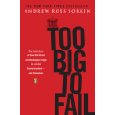You may, like me, be curious about what happened during the Great Credit Crunch. You may, like me, have the feeling we reached a financial precipice, peeking over the edge into the abyss. But before falling in we blacked out and woke up in the hospital, a thick IV needle in the arm, tired and confused but otherwise basically OK, thinking, “But, but, but, wha, what happened back there?”
Andrew Ross Sorkin wants to answer this question for us in Too Big to Fail, his bestselling account of the eight most dramatic months of the Great Credit Crunch. It begins in March 2008 with the demise of Bear Stearns, peaks the week of September 15 2008 (Lehman declared bankruptcy, Bank of America agreed to purchase Merrill Lynch, and AIG got its first $85 Billion bailout by the Federal Reserve) and ends in October 2008 with the mandatory TARP investments by the US Treasury in nine systemically important – aka Too Big To Fail – banks.
Sorkin covered the crisis for The New York times via his Dealbook column, and has a lot to offer us as that front-line journalist, under nearly war-time conditions of high stakes and daily – even hourly -changing conditions. For sheer personal access to the leading protagonists, as well as the rendering of real-time conversations, Too Big To Fail is a helpful first brush at history. No doubt the movie attracted even more attention than the book, because, well, most people would rather watch a movie than read.
For all the attention and acclaim he received for his A-list account of the Great Credit Crunch, however, Sorkin has two big problems. The first is a minor stylistic issue, the second a fundamental difficulty.
Look, Sorkin had a problem in writing this book; namely, how to make concrete action out of events that took place primarily on the financial ledgers of governments and banks. These ledgers do not exactly provide riveting visuals, and I definitely get the feeling Sorkin planned to sell the movie rights before he finished Chapter One. So visuals were key to his plan. As a way to create cinematic action Sorkin highlights every swift swipe of the Blackberry from Hank Paulson’s pocket, every frenzied snatch for the phone while riding in a Town Car zooming away from the Federal Reserve. There’s a lot of gasping and ‘Oh my God!’ horrified looks as bank executives read the latest risk report on their phones from their loyal lieutenants. Paulson’s phone in particular plays a fetishistic role in the book, constantly moving from his ear to his pocket and back. It’s just a quirk of style on the one hand (movie rights must be sold!) but it is nevertheless distracting and silly. Sorkin tries to show the high stakes danger facing Paulson and his deputy Neil Kashkari, but instead merely brings to the reader’s mind Crockett & Tubbs shouting into their oversized car phones, buzzing the Day-Glo storefronts of Miami in 1985.
The more fundamental problem with Too Big To Fail stems directly from Sorkin’s strength as a New York Times journalist – his access to financial executives and government officials. They needed him to tell their story, and he needs them to write his story, but their pact of mutual benefit results in a narrative with no bad guys. In Sorkin’s story, every Dick Fuld, every Tim Geithner, every Lloyd Blankfein and every Jamie Dimon is just a high powered guy with a Blackberry doing his darndest to survive this financial firestorm. They gave extraordinary access to Sorkin, they will give extraordinary access to Sorkin in the future, and there’s really no point in painting any of them in a negative light, now is there?
Hank Paulson made this book happen through repeated interviews with Sorkin, in his attempt to get his (Paulson’s) version of the crisis on the record first. As a result, the one exception to Sorkin’s rule of mutual benefit is Chris Flowers, who clearly got so under Hank Paulson’s skin (their historic antagonism goes back to the ‘90s when both were at Goldman) Sorkin shows him as the backstabbing, untrustworthy thief that he probably is. In this case, Sorkin risks an unflattering portrayal (and really, the shocking thing is that ONLY Flowers is shown in this light) because he needs to present Paulson’s version of the truth. Reading Too Big to Fail I kept thinking that the Wall Street I know has got a lot more unsavory characters than just Chris Flowers.
I do not mean to imply that I prefer a book bashing the heads of Wall Street firms. There are plenty of those, and frankly they’re even less helpful than Sorkin’s book. What we do need, however, is some analysis that might make Sorkin’s sources uncomfortable. We need a chronicler of the Great Credit Crunch to contextualize what happened, to explain the forces at work that put us in this situation in March 2008 in the first place. Less necessary is Sorkin’s entire book – which can be summed up as: ‘There were a bunch of aggressive but basically good guys working late nights and weekends to save their bacon and that of their firms, and it was really scary but kind of exciting to be there with them.’
If you read the news as obsessively as I did during that period, you know the basic facts, and Sorkin tells us a lot more basic facts of who said what to whom, and when, and what late model Blackberry they used. But now we’re lying groggy in the ICU with that thick IV muttering, “OK, I know WHAT happened, but WHY?”
Please also see related post, All Bankers-Anonymous Book Reviews in one place.
Post read (2543) times.



